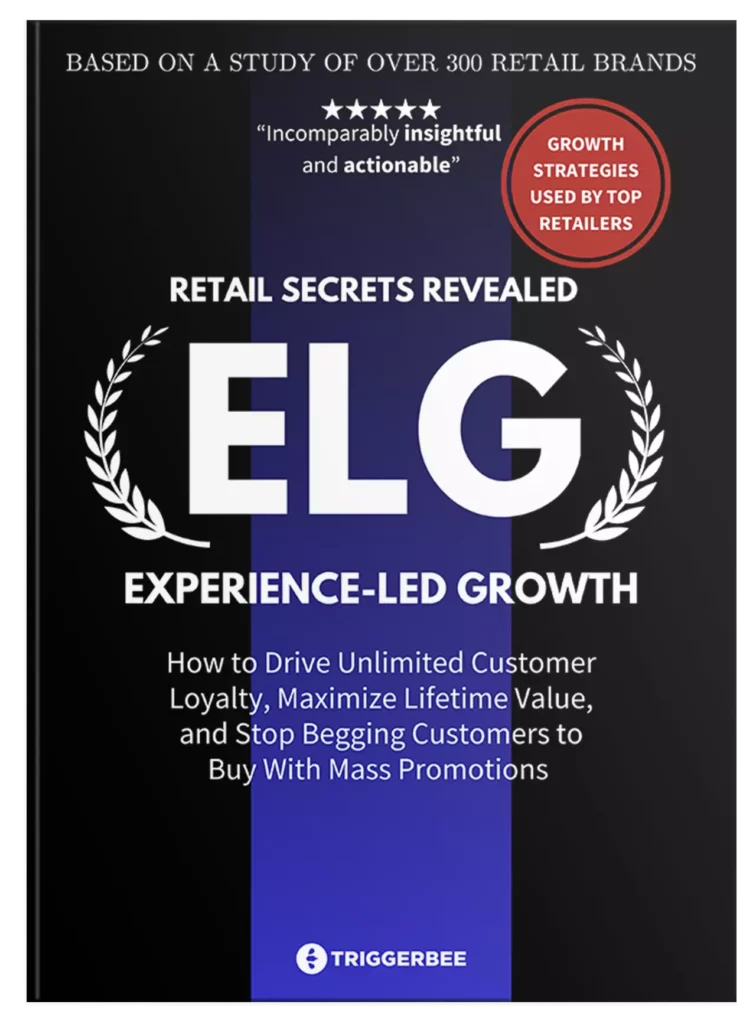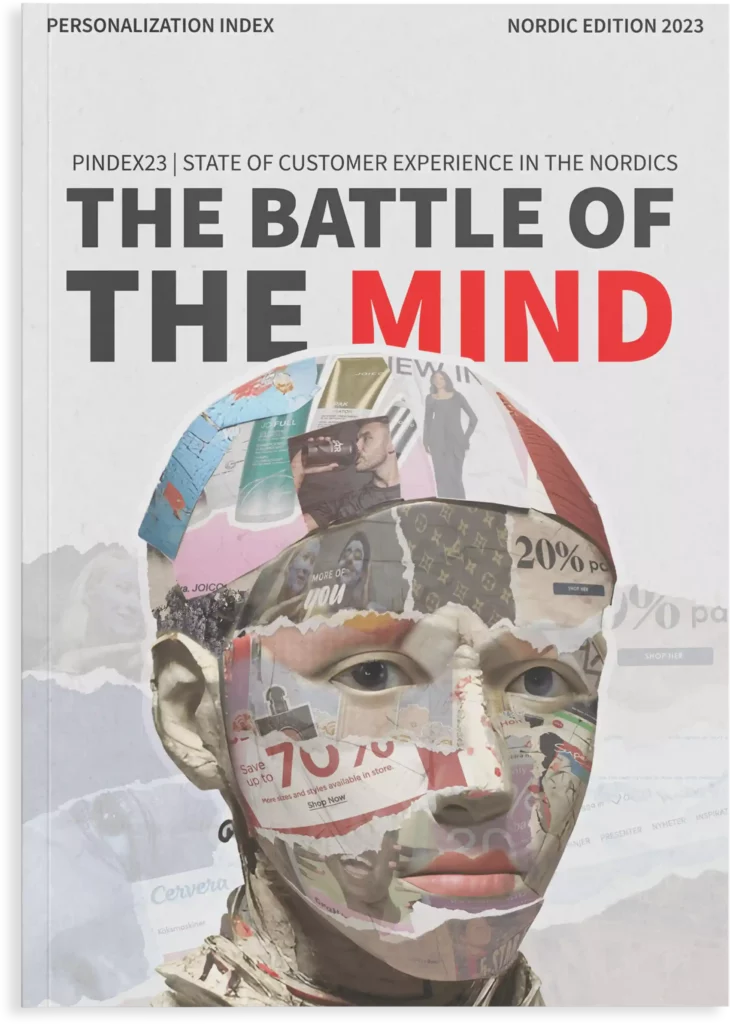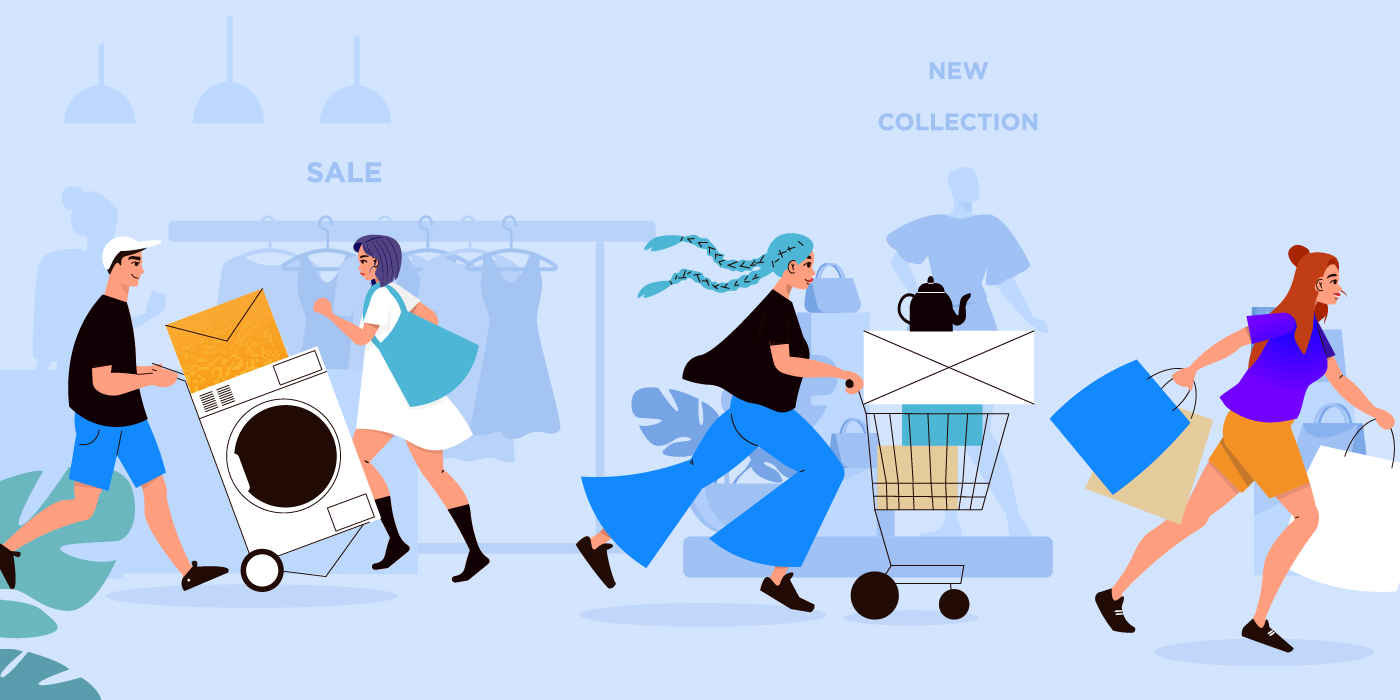This is a complete guide to eCommerce personalization.
In this in-depth guide you’ll learn:
- How to use the data you collect to create personalized customer experiences your competitors can’t copy
- Why product recommendations are not “cutting edge” anymore
- How to use your customer data in your discount and promotion strategy
- How to grow your list with personalized signup forms
- How the best eCommerce brands use personalization
So if you’re ready to go “all in” with eCommerce personalization, this guide is for you.
Ecommerce Personalization: The Basics
Let’s start with the basics of personalization.
If you already know how personalization works, go ahead and skip to the advanced personalization strategies and real-world examples.
In this chapter, you’ll learn how personalization works, what it is, and why it’s important.
What is Ecommerce Personalization?
Ecommerce personalization is the practice of using customer data to create individually tailored shopping experiences. Some examples of ecommerce personalization include product recommendations, discount code reminders, audience-specific promotions, and the use of first names in various communications.
According to McKinsey, personalization can boost your online sales by 10-25%.
Other studies have found that the difference in average order value for a personalized online store compared to a “regular” online store can be as high as 89%.
But there’s a lot more to personalization than product recommendations and {{firstname}}…

The Importance of Ecommerce Personalization
Your customers expect a personalized experience, it helps your company to maximize the value of your existing customer base, and good customer experiences drive loyalty, customer retention, and repeat purchases.
But personalization truly shines when it comes to decreasing friction, anxiety, and confusion throughout the customer journey.
Here are the top 3 reasons why personalization is important:
#1 Better experiences
Personalization helps you create experiences your competitors can’t copy.
#2 Personalization is expected by your customers
Over 75% of your customers expect personalized shopping experiences, and 71% get frustrated with irrelevant content.
#3 It helps you maximize the value of your existing audience
Personalization done right will help you increase your average order value and customer retention. On top of that, if your discount strategy is based on giving out discounts to everyone who visits your site, you can be more selective and only target specific individuals who need an extra push. You can also generate unique coupon codes for an added layer of security and to increase the feeling of exclusivity.

But it doesn’t stop there.
- Over 90% of marketers believe that personalization is important, according to a survey from Econsultancy and Google.
- Over 88% of all e-commerce stores use some form of personalization.
But…
Only 23% of consumers believe that retailers and e-commerce brands are doing a good job of delivering personalized experiences.
In other words, there’s a lot of room for improvement.
Here are two screenshots showing the results from two real onsite campaigns. Can you guess which one uses personalization?
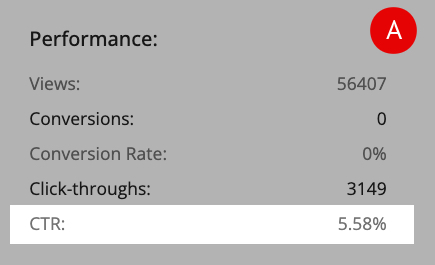

Hint: B – The one with the highest CTR.
Campaign A has almost 5x more views and fewer clicks compared to campaign B, which is personalized. These are game-changing results.
- Campaign A promoted a 25% discount on a newly released product and was shown to everyone visiting the website.
- Campaign B reminded loyalty-program members of their unused members-only discount codes.
Pretty neat.
Most e-commerce brands are trying to catch the same fish as everyone else.
The standard e-commerce playbook is made up of discounts, email- and influencer marketing, affiliate programs, and social and search ads.
Personalization is important because it’s basically owned growth. It helps you as a brand deliver better customer experiences with the help of your existing customer data, which eventually creates a positive growth loop where every interaction lays the foundation for a better experience.
When to focus on personalization
Personalization is especially important for mature brands that already have a loyal customer base.
Whether you should focus more on customer acquisition or personalization is heavily influenced by where your brand is in its lifecycle.
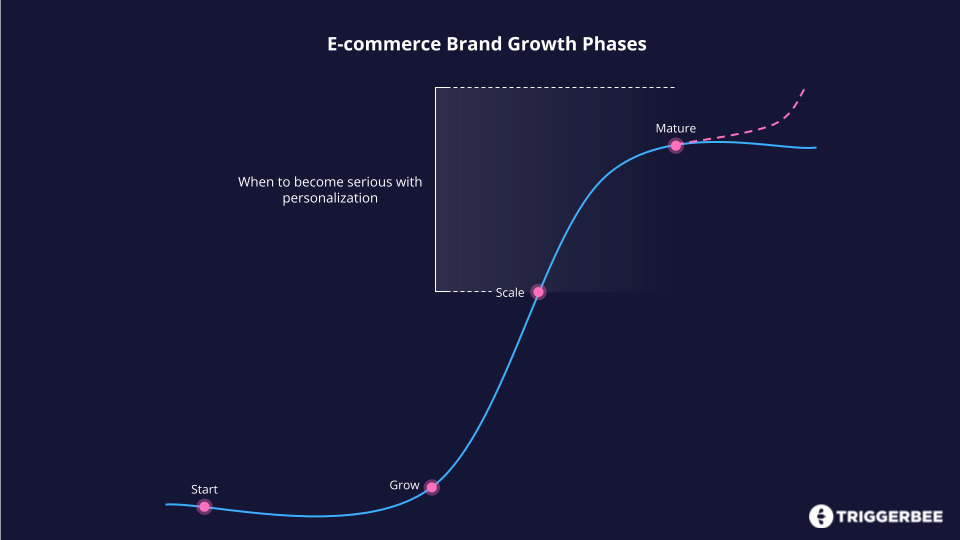
1. Start | Customers: 0 – 100 | Contact/Email database: 0 – 1 000 contacts
When you’ve just started your store, there is only one thing you should be focused on: getting customers. At this point, you should not even think about personalization. Focus on growing your email database for bigger outreach and getting your first customers. Your discount strategy is critical for growth in this phase.
2. Grow | Customers: 100 – 1 000 | Contact/Email database: 1 000 – 50k contacts
You now have customers and a growing email list, and you are regularly getting sales. At this stage, you can begin to think about personalizing your email campaigns and promotions on your website. Even simple strategies like greeting email subscribers when they visit your website differently than visitors from Instagram can make a huge difference.
3. Scale | Customers: 1 000 – 10k | Contact/Email database: 50k – 200k contacts
You don’t run an e-commerce empire yet, but sales are growing. This is the point where you should begin to think about implementing a loyalty program and start using some e-commerce personalization tactics alongside your acquisition efforts. For example, build out audience segments in your email database or CRM, and target those segments on your website with personalized promotions. Prevent abandoned carts with emails and onsite campaigns, and remind customers of unused discount codes.
4. Mature | Customers: 10k+ | Contact/Email database: 200k – 500k contacts
You are now an established e-commerce brand. A common problem for retailers of this size is finding ways to continue to grow. That’s where personalization comes in. Your acquisition strategy may lead to a lot of one-time purchases, but with a solid ecommerce personalization strategy, you can increase your customer loyalty, retain, and maximize the value of each customer. At this stage, you need to be serious and deliberate about creating customer experiences that your competitors can’t replicate. This is the stage where you need to communicate with your customers based on their membership status, purchase history, and audience segment.
5. Mature and beyond | Customers: 100k+ | Contact/Email database: 500k – 1M+ contacts
At this stage, you are basically a household name. You’ve achieved many successes and you have a lot of processes in place. Now is the time to focus heavily on personalization.
Let’s take a look at a graph that explains the effectiveness of personalization depending on which tactics you use.

The more you understand about your customers, the better you will become at personalization, and the more your customer lifetime value will increase.
How Ecommerce Personalization Works
Personalization needs user and customer data to work. Most of the data used in ecommerce personalization can be classified into two categories:
- First-party data
- Zero-party data
Let’s go through both.
First-party data
First-party data refers to any data you collect from your customers without them being aware of it being collected. It sounds a lot scarier than it is, but if you have any analytics software installed on your site, you already collect first-party data.
Examples of first-party data in e-commerce:
- Link clicks
- Visited pages
- Product attributes (i.e. Size/Color selection)
- Products added to cart
- Opened newsletter
- Claimed offers
Most of this data is based on behavior and can be used to create customer segments based on their website activity.
However, all this data is great when used for personalization purposes. For example, you can use exit intent popups to capture customers who are about to abandon your site with products left in their cart.
Zero-party data
Refers to the data that your customers intentionally and willingly share with you, in exchange for a better experience or added value.
Examples of Zero-party data in e-commerce:
- Clothing size
- Favorite brands
- Gender
- Communication preferences
- Style preferences
- etc
Zero-party data is a gold mine for personalization. But how is it used, in real life?
Here are three real-world examples of e-commerce brands that collect and use zero-party data for personalization:
#1 – Zalando
Zalando collects style preferences based on 1) influencers you follow in their app, and 2) which brands you have marked as favorites in your profile. Combined with your purchase history, they use this data to generate personalized product recommendations that you are likely interested in.
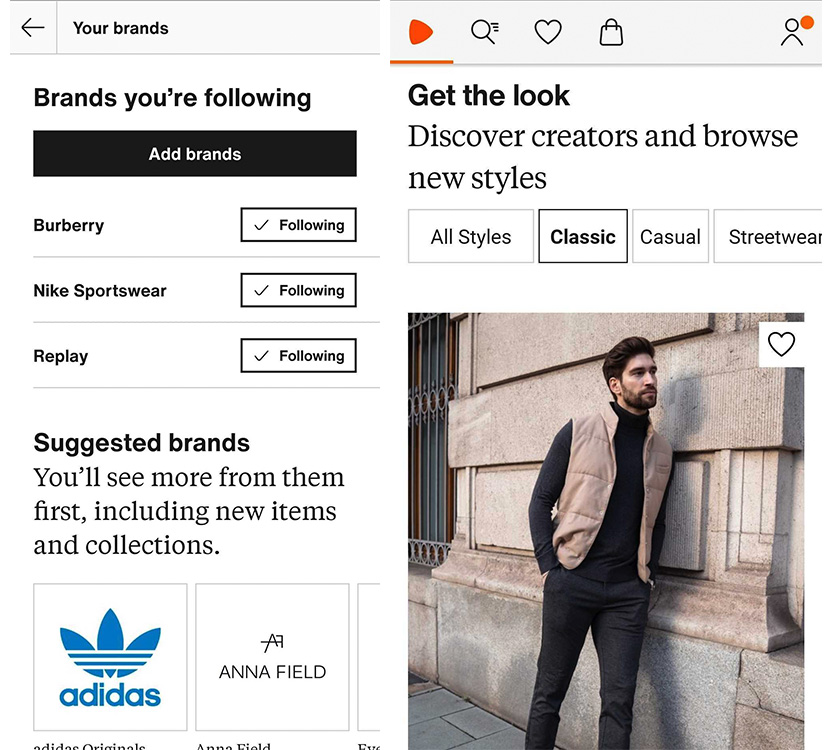
#2 – Sephora.
If you register an account with Sephora, they have something they call “Beauty Traits & Color IQ”. This is your “beauty profile” where you can register your skin tone, skin concerns, eye color, hair color, and a bunch of other stuff.
Once you have registered your beauty traits, you can use it to filter reviews from other people with the same traits as you!
Sephora also uses personalized product recommendations, and personalized promotions targeted to you based on your membership level. But they have something that nobody else has: personalized customer review-filters.
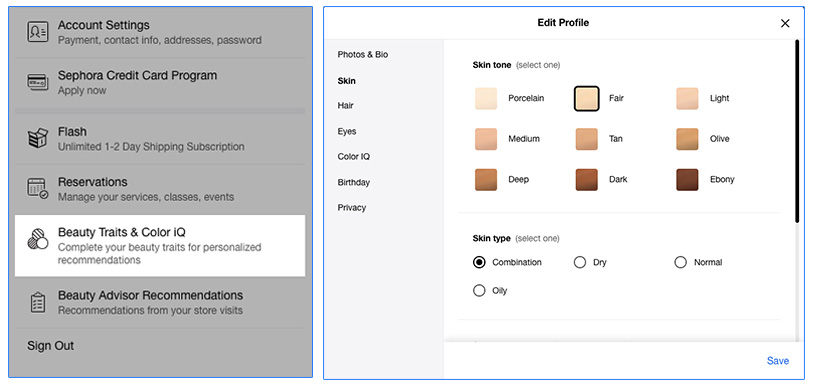
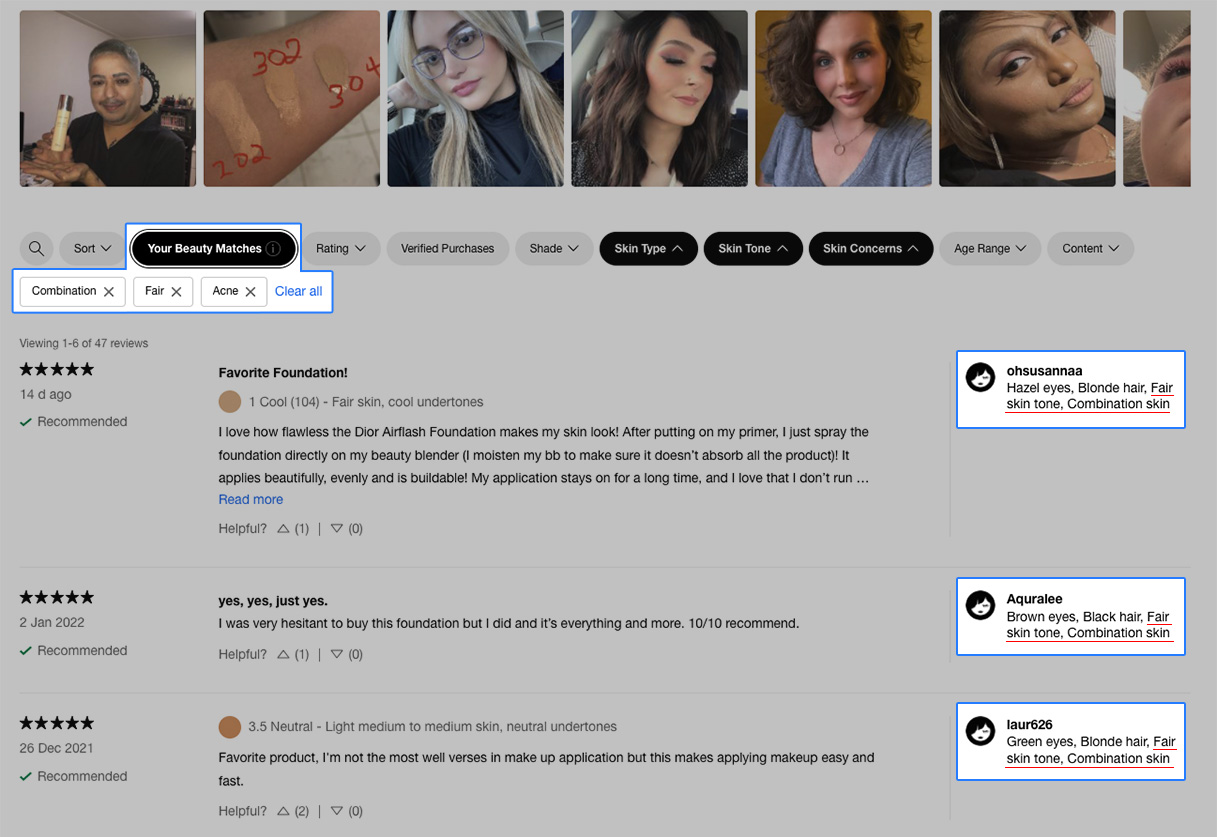
#3 Nordstroms
Nordstroms use clothing attributes to tailor and adapt its personalized product recommendations. Once you select a size, the product recommendations change to prioritize products with your selected size available.

As you can see, zero-party data can be used in a lot of different ways.
You need to find ways to use it in your own business, because the use cases are highly dependent on the products you sell, and how your customers navigate your website.
Customer profiles
A customer profile is a detailed customer record that contains both zero-party, first-party, and transactional data. Below you’ll see a table of data that can be found in a customer profile along with example use cases.
| Data | Type | Example use | Stored in |
|---|---|---|---|
| Contact information (E-mail address, name, phone number, address) | Zero-party | - "Hello {{fname}}" - Pre-filled forms - Discount code validation | - CRM - Email database |
| Behavior (Clicks, visited pages, time on site, traffic source etc) | First-party | - Onsite Targeting - Email segmentation - Promotion targeting | - Onsite platform - Email database - CRM - Cookies |
| User preferences (Email frequency, shoe size, favorite brands, shopping occasion) | Zero-party & First-party | - Promotion targeting - Upselling - Product recommendations | - CRM - Email Database - Cookies |
| Conversion actions (Products in cart, size guide usage, returns, checkout visits) | Zero-party & First-party | - Onsite Targeting - Triggered emails (abandoned cart) - Nudging | - Onsite platform - CRM - Email Database |
| Customer data (Purchase history, loyalty status, average order value, etc) | First-party | - Product recommendations - Member offers - Up-selling | - Onsite platform - CRM - Email Database |
Here is a screenshot of a customer profile in Triggerbee, an onsite personalization software.

When you take a closer look, a lot of the available data can be used for personalization:
- User information (“Hello {{fname}}”)
- Number of visits
- Device usage
- Website activity
- Visits
- Audience belonging
- Interests
- Visit source
A customer profile is based on behavioral data and expands with each visit. It builds up as each user in your audience clicks links in your emails, makes purchases, and interacts with your brand’s owned channels (website, email, SMS).
You can use data from a customer profile to show and hide content on your website, send out personalized email campaigns, remind people of products in their shopping carts, generate personalized product recommendations, and build website audiences based on behavior in a similar way to how you create segments in your email marketing software.
Channel selection
To tell you the truth, you don’t really have much to choose from when it comes to channels if you want to personalize your marketing and communication.
You need full control over audience targeting, the appearance of your messages, content, and which data is being used.
Here are the three channels you can use for e-commerce personalization:
- Website
- SMS
These three channels are the only channels you own. They are called “owned” because you own and control the data you collect and use in those channels.
Compare this to social media or search. Your followers on TikTok, Instagram, YouTube might be “your” followers, but the parent companies control the organic reach. You have zero control over your impressions, distribution, and appearance.
When you advertise on those platforms, you basically rent the data.
In your owned channels, you own all the data. You control every parameter up until the moment when your audience receives your message.
This leads us to the next step: designing personalized ecommerce experiences.
The difference between personalization and personalization (what?)
It might come as a surprise, but personalization doesn’t necessarily mean that everything should be “personalized”. Behavioral segmentation and self-submitted preferences from your customers are the foundation of a good personalization strategy.
In reality, here are the two most important things:
- Personalization = relevance
- The overall user experience matters more than the actual degree of personalization
Here’s what we mean:
The overall user experience needs to be good. And personalization is a huge part of a good user experience.
However, it doesn’t mean that every interaction should or needs to be personalized. In some cases, personalization can become too much and feel forced.
Instead, the goal of personalization should be increased relevance.
Think of it like this:
Imagine yourself regularly visiting a local restaurant 2-3 times a week for several years.
It wouldn’t take long before you know the full staff. And for each visit, you have a better experience.
The restaurant staff will eventually be able to guess what you will order, and they know what’s going on in your life. You come back again and again because you know you will have a great time.
Now, imagine if that same restaurant suddenly would get a new owner that replaces the full staff, creates a new menu, and increases the prices.
Would you still go there? Maybe. But would it feel the same? No way.
You should think about ecommerce personalization the same way. The experience for your most loyal customers should be highly personalized and relevant. But for new visitors and new customers, you need to make a good first impression with a few elements of personalized interactions.
Designing Personalized Ecommerce Experiences
The most important part of designing personalized e-commerce experiences is finding out how to add value to every step of the customer journey.
One of the fastest ways to get started is by making a customer experience analysis.
Step 1: Perform a Customer Experience Analysis
If you don’t know how your customers experience your customer journey, you are going to have a hard time effectively using the right personalization tactics.
The solution? Perform a customer experience analysis.
Start by mapping out 3 or 4 customer journeys and their most important interactions.
But don’t map out every single step in every journey. It takes too long and it will just become confusing. Keep it simple.
Here are four example journeys:
- New customers, coming from ads
- New customers, coming from influencer links
- Subscriber, coming from email campaigns
- Existing customers, coming from emails
Write down each step of your selected journey(s), like this:
- Sees an ad (define which ad + landing page)
- Visits website (define landing page)
- Checks out products
- Compares price on another site
- Comes back to the website
- Signs up for the newsletter and gets 10% off
- Gets a welcome email with the discount code, and visits the site from the email.
- Adds product to their shopping cart
- Completes purchase
This is a very simplified journey for a new customer, but that’s really all you need.
When you have mapped out a couple of journeys, here are four things to look for and take note of in every step and interaction:
Clarity: Is every step as clear as it could be?
Friction: What’s causing doubts and hesitation?
Anxiety: What makes “me” cringe?
Distraction: Are there multiple distractions? Do I know what I want and need to do on the page?
Let’s go through each step:
Clarity
Main question: Is every step as clear as it could be?
What you’re looking for here is if the next step is 100% clear. In the context of personalization, you’re looking for things that can be clearer with the help of personalization.
For example, if you send out a discount code via email, are you showing that discount code on your website for people who click on your email?
Getting a discount code in an email campaign, but not seeing it on the website is a very common problem that easily can be fixed by using personalization.
Missing clarity will also cause friction, which brings us to the next point…
Friction
Main question: What is causing doubts and hesitation?
Anything that makes you feel confused, annoyed, frustrated, or insecure is a source of friction. Friction can be anything from not being able to log in, to not knowing what your discount code is, to feeling confused.
Here’s a real-world example…
One of our customers asked us how they could use Triggerbee’s software to make their influencer marketing more effective. We tried a lot of stuff and helped them set up some onsite campaigns.
The results didn’t really change until we found out that the transition from Instagram to the website was the issue.
All of their influencer links led to a category page – and not a specific product page. So, if you wanted to find the product being promoted by the influencer, you needed to find it yourself.
This caused massive friction.
So, we helped them build an onsite campaign that looked like a website chat, and the chat image was tailored to each of their influencers. When someone on Instagram clicked on an influencer link, they were greeted with a message that looked like this:
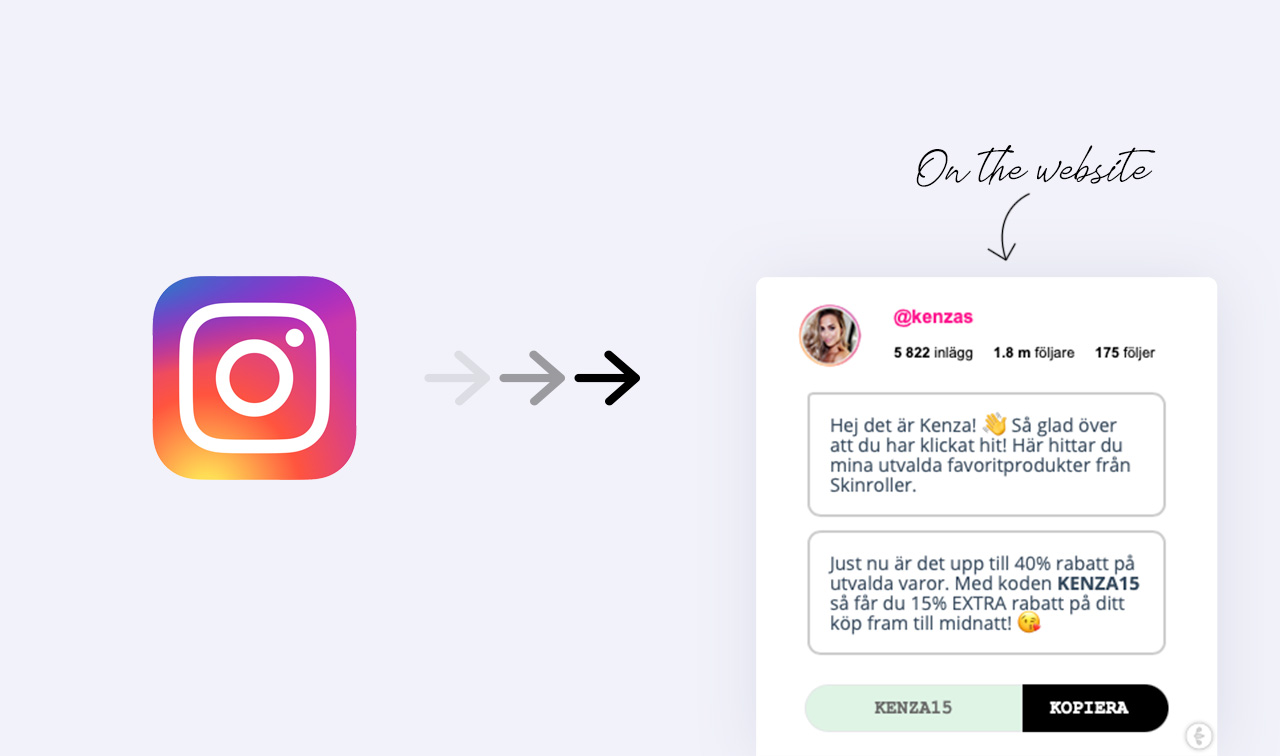
The result of this simple ecommerce personalization tactic? Over 20% average CTR.
This makes for a much better user experience and helps decrease friction caused by channel transition.
It’s your job to make every step in the customer journey as intuitive, simple, and non-complicated as possible. So, look for situations that can be simplified using personalization.
Anxiety
Main question: What’s making me “cringe”?
Anxiety is a function of your brand’s credibility and the trust you are asking your customers to have. For example, you can trigger “anxiety” by asking for unnecessary information in the wrong context (i.e. asking visitors to type in their phone number in a newsletter signup form).
If you encounter a situation where you think “why?” or feel stressed, you’ve found an anxiety trigger.
Here are two common anxiety triggers:
- Not being consistent. If you display a promotion or discount code on your homepage, you also need visual clues on the product pages that are affected by the promotion. The same thing goes with members-only promotions. If you send out an email with a discount code, make sure to visually display that discount code on the website as well.
- Insecurity. A super common example is influencer links leading to a category page or homepage, and not to a specific product page. This can lead to confusion, especially if there is no clear guidance on the landing page on how to find the product being promoted.
Distractions
Main question: What is distracting me?
The more visual inputs and actions your visitors have to process, the less likely they are to make a decision that leads to a conversion. Look for actions that can be pre-populated based on the customer data you collect.
Pre-populating size/color selections like Nordstrom, or having a good selection of related products are both great ways of minimizing distractions.

Product recommendations are great. But they need to be relevant.
Your conversion analysis should result in:
- A list of situations where personalization can be used.
- A list of tactics that can help minimize friction, distractions, and anxiety.
- A list of audience segments that need to be targeted.
And that’s all there is to it.
Step 2: Building Personalized Ecommerce Experiences
Every e-commerce store will have unique challenges. But there are a few tactics that can be applied in almost every online store, and work immediately.
Examples of Ecommerce Personalization
See how top e-commerce brands use onsite personalization in various ways to enhance the experience for their users.
These are the tactics we’ll take a look at:
Abandoned Cart Recovery (On the website)
70% of your visitors will abandon their cart. And unfortunately, it’s one of those things that you just need to live with. You can, however, decrease and prevent them from happening.
Here are the top three reasons for cart abandonment:
- Unexpected costs (shipping and other fees)
- Mandatory login/registration
- Long or complicated checkout process
You probably know abandoned cart emails are effective. But they have two problems:
- The recipient needs to be identified or exists as a contact in your email database
- The email is sent after the user has left your website
A better way to prevent abandoned carts is by using Exit Intent popups.
An exit-intent popup is a modal that appears when your visitor is about to leave your website, or more specifically when they move their cursor towards the address bar in their browser (or hits the back button on mobile).
Exit-intent messages are great because they don’t disturb the browsing experience until the visitor is about to leave.
Here’s why you should use it:
First, the user is still on your website and they are close to conversion. Second, the user doesn’t need to be identified.
Here are two ways to use Exit Intent messages that can prevent cart abandonment:
Xlash
Swedish retailer Xlash used a 15% discount in their checkout to persuade visitors to finish their purchase.

Targeting: Broad | Everyone
Why it works: Most people abandon their shopping carts because of unexpected or too high costs. By offering a discount that is as close to the conversion as possible, you can persuade at least some people to take the offer and proceed with the purchase.
K-Rauta
Swedish construction retailer K-Rauta uses discount reminders to incentivize new email subscribers with a 5% discount code:

Targeting: Narrow | New email subscribers
Why it works: Whenever someone signs up for K-Rauta’s email list, they receive a 5% discount code. However, far from everyone who signs up uses their discount code. K-Rauta knows that customers who use discount codes spend 52% more on average, so instead of letting people forget they show a reminder during checkout.
Your homepage is your digital front door.
And it’s up to you to greet new customers in the best way possible.
Dunken, a Swedish brand selling rock-themed clothing, uses a personalized homepage banner:

Based on which button you click, the layout will change and display buttons leading to the most popular women’s or men’s clothing categories.

They have over 15% CTR on this banner, so it’s helping visitors navigate through their website.
Driving new membership signups
If you have a loyalty program, recruiting new members should be a top priority. KICKS is one of the largest beauty retailers in the Nordics, and they offer new members a 20% discount on their first purchase.
They also show personalized discount reminders based on your membership status once you are a member.
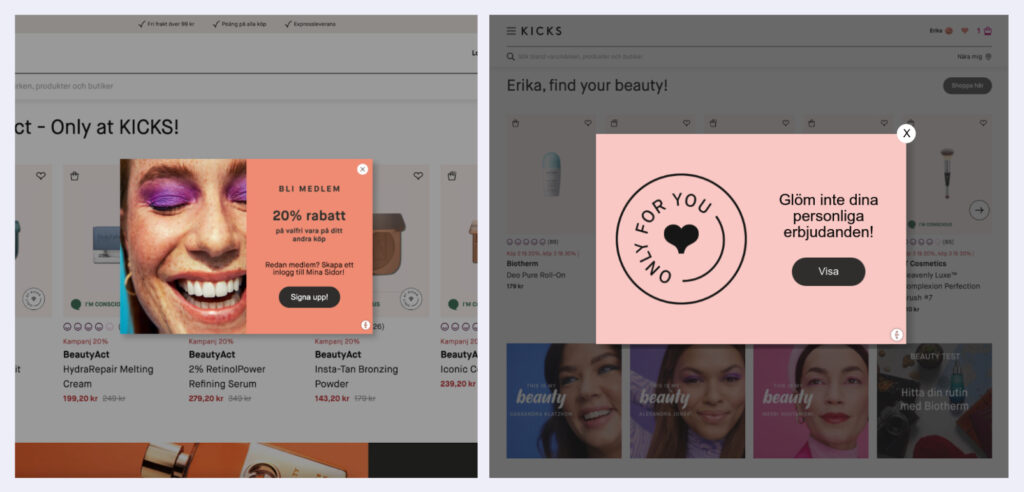
Targeting: Broad | Non-members
Why it works: If you already are a club member, you don’t want to be asked if you want to register for membership again. Plus, avoiding impressions from existing members can increase the conversion rate.
Members-only raffles and competitions
All Things Commerce is the parent company of the Moomin brand. They have a LARGE membership club that is very enthusiastic and engaged. To keep their members engaged, they regularly host raffles and competitions.

Targeting: Narrow | For club members
Why it works: All Things Commerce does not incentivize new members or signups with discount codes as most regular e-commerce stores. Instead, they save the special treatment for their members which makes it even more effective for that particular audience.
Pre-launch campaigns
Bubbleroom is a Swedish retailer selling women’s clothing.
Influencer marketing is an important part of their marketing strategy, and they release collections designed by influencers multiple times each year.
They use a pre-launch strategy to generate demand before an official launch. The message is generic, but the targeting was highly personalized.

Targeting: Narrow and broad | Members-only and everyone
Why it works: Influencer collaborations are very popular. And Bubbleroom knows the power of segmentation. Their loyal members get the offer first, which creates exclusivity.
Email personalization examples
If you’re not personalizing your emails, you are leaving money on the table.
Here are some effective tactics you can use:
- Personalized content
- Demographically targeted campaigns
- Reminders
- Celebrations
Let’s take a look at how Rituals uses personalization in their email marketing.
How Rituals use personalization in email
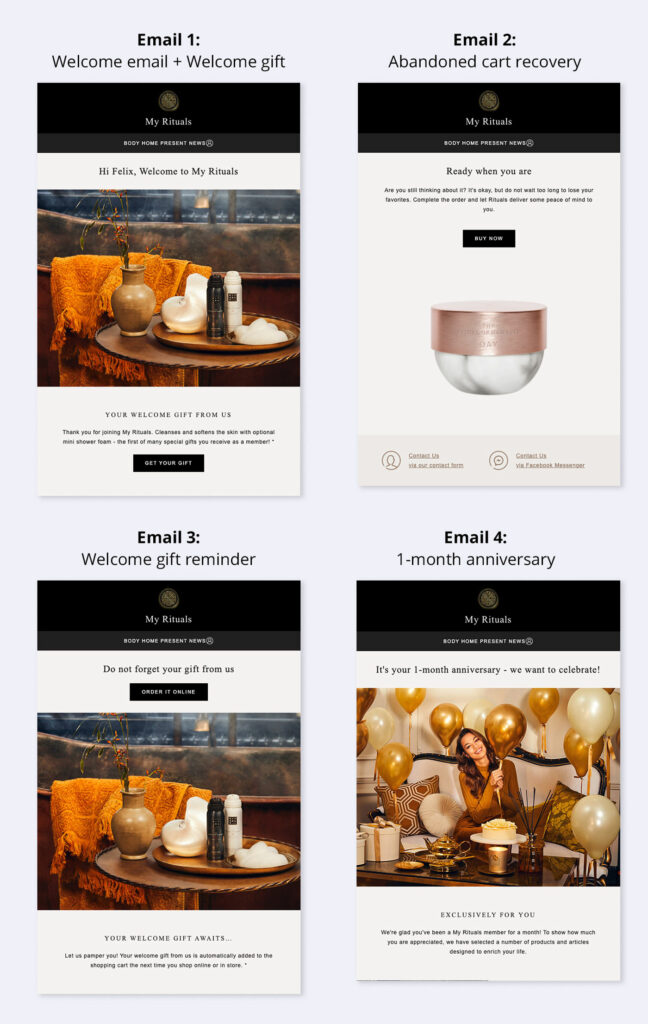
Rituals obviously know how powerful personalized ecommerce emails can be. They have a distinct look and feel, and they make sure to stack the odds in their favor by sending out reminders and celebrating anniversaries.
Just by using time and activity as a basis for how to sequence your emails, you can easily increase the relevance of your communication.
Personalized welcome emails
You only have one chance to make a good first impression. And if your first email to new subscribers or members isn’t memorable, they won’t be very excited to open your campaign emails either.
Welcome emails drive 3 times the transaction and revenue per email, compared to other promotional emails.
The role of your welcome email should be to introduce them to your brand, set expectations for what’s to come and introduce them to any benefits.
Personalized reminder emails
Discounts are wildly effective as a customer acquisition strategy and for building your email list. However, even if someone signs up for your newsletter to get a 10% discount code, chances are they won’t use it
At first glance, it sounds like the perfect offer. Especially considering a lot of e-commerce companies are trying to become less dependent on discounts.
But what if I told you that customers who use discount codes spend on average 52% more?
Then you would want to make sure that everyone who receives a discount code, uses it.
You can use personalization to incentivize your new subscribers to use their discount codes.
It’s actually good for business!
Here are some examples of personalized discount code reminder emails:
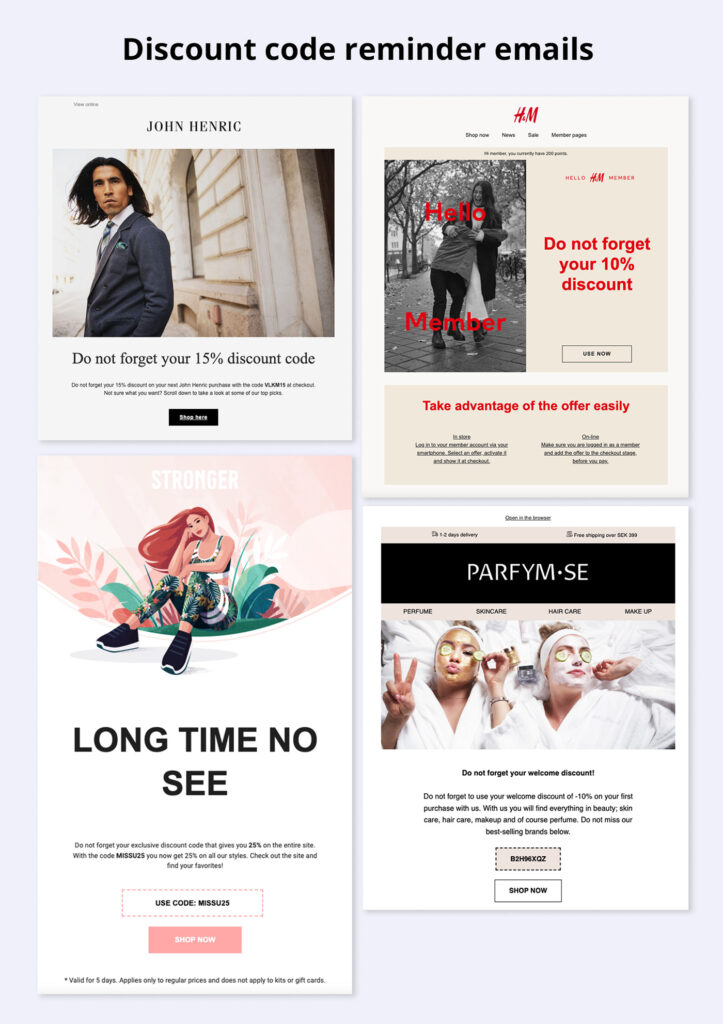
Personalized abandoned cart emails
Abandoned cart emails are emails that you send to re-engage shoppers who left items in their carts, without purchasing.
Cart abandonment emails should be sent out within 1-3 hours for maximum performance. Regardless of the reasons that shoppers abandon their shopping carts, you have a very limited window to win them back.
You’ve probably seen your fair share of abandoned cart emails. But have you ever seen an abandoned cart email that leads to even more personalized follow-up emails?
Sellpy is a Swedish brand selling second-hand clothing. They only have one or two of each product in stock at all times, which makes it very hard to effectively recommend products.
Below you’ll see an image of how they personalize their abandoned shopping cart-emails, and use that data to recommend other products in subsequent emails.

Impressive, right?
Personalized campaign emails
There’s a lot more to email marketing for e-commerce stores and online retailers than simply sending a weekly email with promotions and discounts.
KICKS uses demographic personalization for its campaign emails.
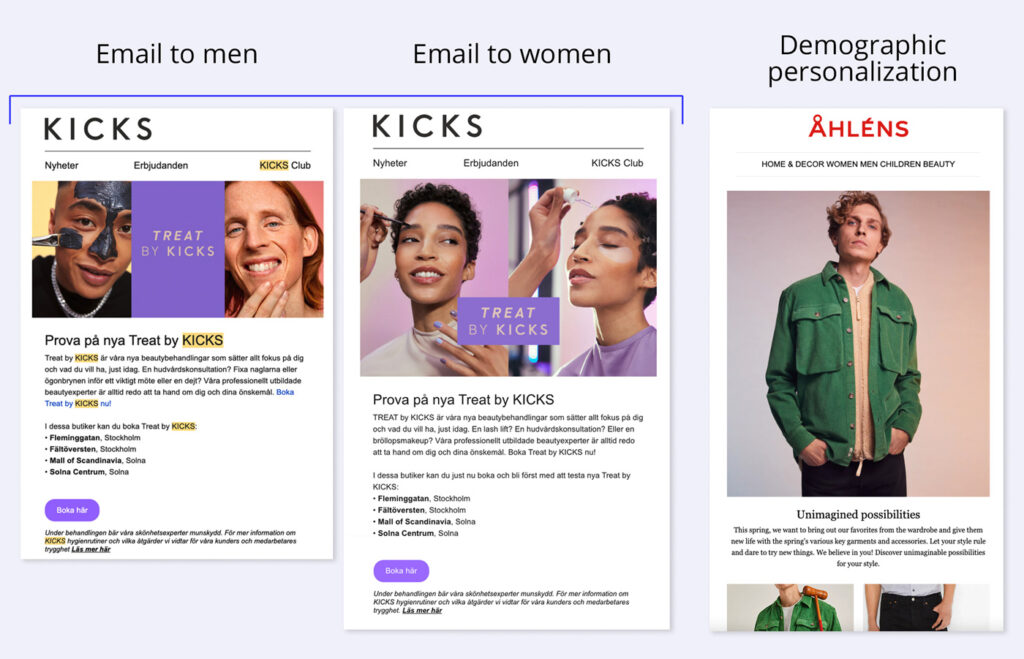
Instead of receiving a campaign with generic offers and messaging, demographic personalization offers your subscribers emails that are targeted directly at them and provides offers (products, promotions, etc.) that are relevant to their interests.
Personalized celebration emails
Celebration emails are one of the most effective emails that you can send. According to Experian, birthday emails have a 481% higher transaction rate than regular promotional emails.
They generate 342% more revenue and 179% higher click rates than regular promotional emails.
Here are some awesome examples:
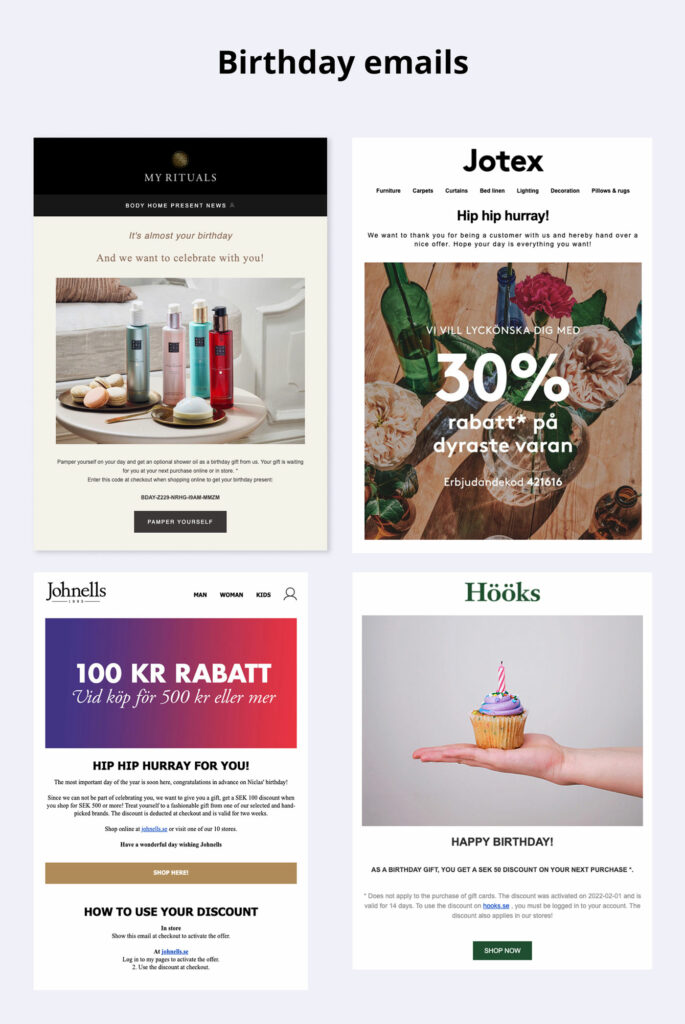
Summary
Personalization can create a new revenue stream for your e-commerce brand, especially if your business is at a stage where you have a large audience, but you’re still focusing on customer acquisition.
Your current data, and your current audience is your most valuable asset.
Personalization can help you unlock the value of your current audience, and with the help of data, create experiences that will increase your customer loyalty, retention, average order value, and much more.
But remember: Don’t try to do everything at once. Start small and take it step-by-step.
